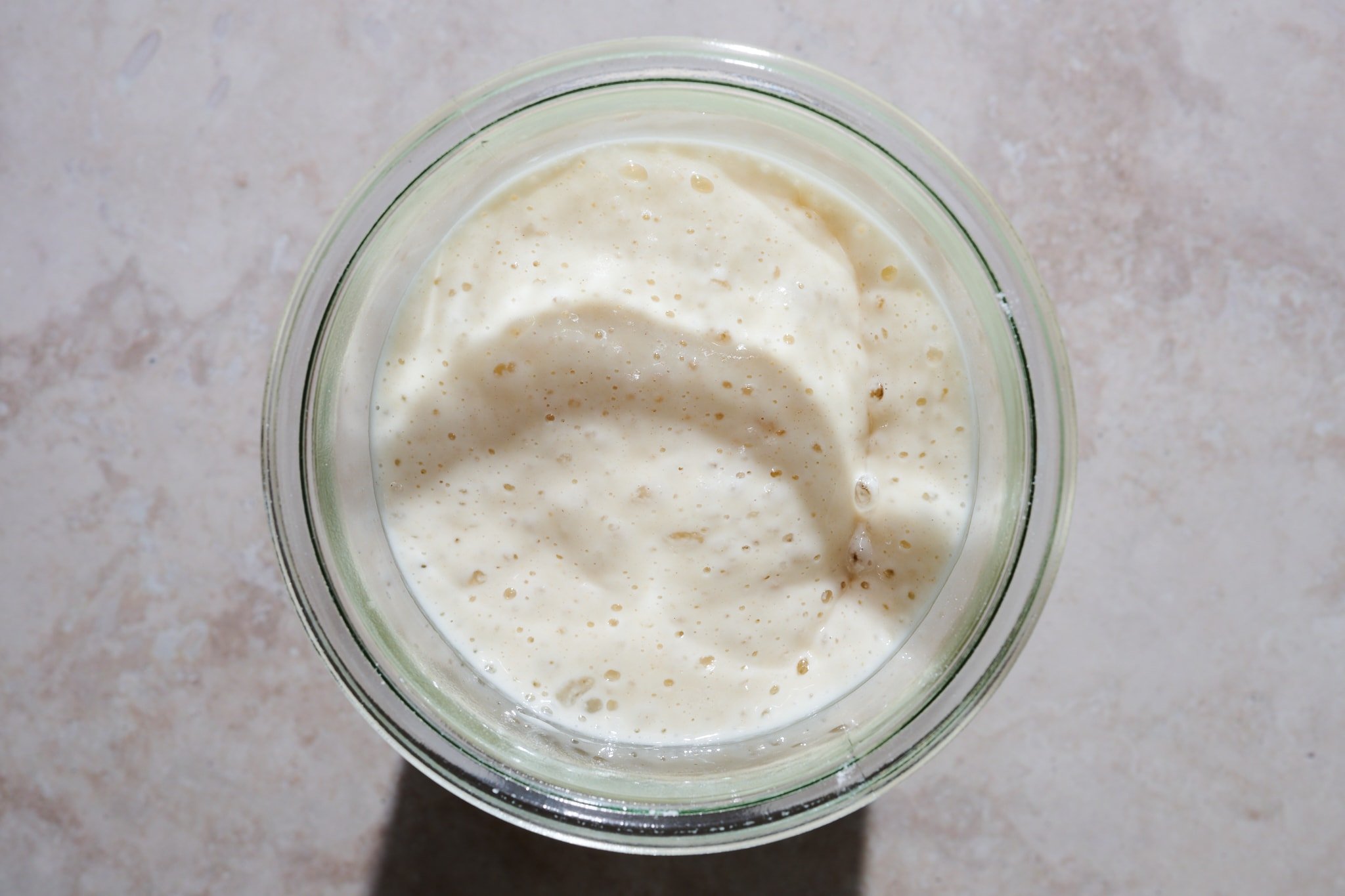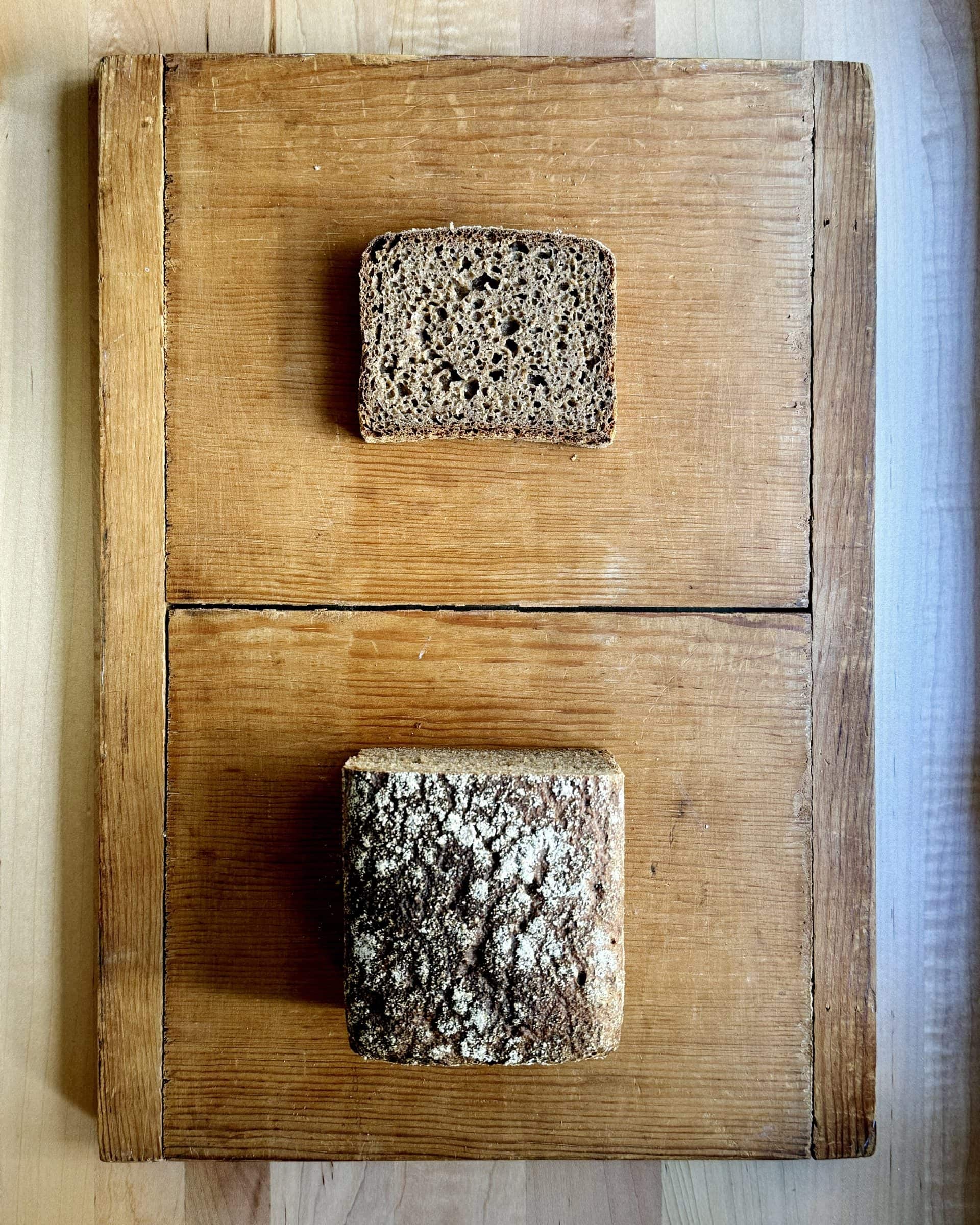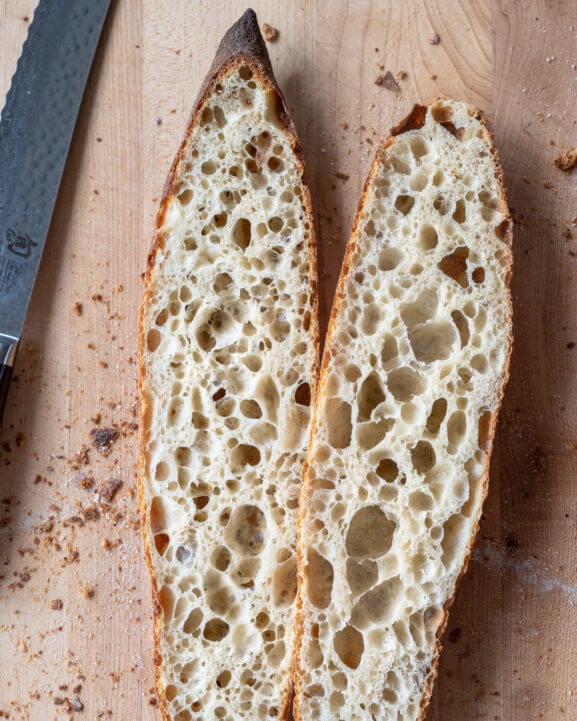With this primary submit, we welcome Andrew Janjigian to The Good Loaf. Andrew is a long-time bread baker, baking trainer, recipe developer, author and photographer who writes a bi-weekly publication about all issues bread and grain known as Wordloaf, and likewise occurs to be engaged on his first bread cookbook. Welcome!
A fast notice from Maurizio. Whereas this submit by Andrew is supposed to spotlight the usefulness of economic yeast in baking and hybrid doughs, The Good Loaf stays devoted to sourdough bread baking. With out additional ado, let’s dive in.
This is perhaps a considerably controversial matter for The Good Loaf, an internet site dedicated to all issues sourdough, however I’d wish to dispel the notion that sourdough (and the wild yeast it incorporates) and business yeast can’t go hand in hand. Generally. In truth, there’s really an extended custom amongst skilled bakers of including small quantities of economic yeast (bought in numerous classes often called “energetic dry,” “instantaneous,” and “recent” or “cake” yeast) to sourdough breads to advertise good oven spring—a hybrid dough. The addition of yeast also can change the feel, taste, and preserving qualities of the bread—for higher, or worse. You would possibly by no means have the necessity or need so as to add yeast to your sourdough bakes, however the follow is value understanding about simply the identical.
All of which implies that including business yeast to a sourdough fermentation shouldn’t be an unnatural, alien follow.
Sourdough fermentations work by way of the synergy between two units of organisms, yeasts and lactic acid micro organism, each of which devour easy sugars which might be derived from the starches within the flour. The yeasts primarily make the carbon dioxide that offers bread its quantity (together with ethanol and a few taste compounds), the place the micro organism primarily make acids, which offer the bread’s signature tang (although they do produce small quantities of carbon dioxide underneath sure situations).


There are various totally different species and strains of each yeasts and lactic acid micro organism in anybody sourdough starter, and every starter seemingly incorporates a singular mixture and ratio of various organisms. However one of the vital widespread and plentiful yeasts present in sourdough starters is Saccharomyces cerevisiae, aka “brewers” yeast. And whereas the pressure of S. cerevisiae in sourdoughs is totally different than the one used to make business yeast, they’re each the identical species. And although the sourdough-specific strains of S. cerevisiae are a lot better tailored for the high-acid surroundings they exist in, the strains in business yeast can nonetheless thrive within the presence of acids, no less than for the brief durations of a dough’s fermentation.
All of which implies that including business yeast to a sourdough fermentation shouldn’t be an unnatural, alien follow. In truth, in France, the place bread baking is a extremely regulated business, bakers are legally allowed so as to add as much as 0.2% business yeast and nonetheless name the bread a sourdough.
Sourdough yeasts can after all produce all of the carbon dioxide wanted to provide bread loft; nonetheless, there are quite a few practices bakers use to extend that yeast exercise in a purely sourdough tradition. To call a couple of: Common feeding of the sourdough at room temperature; a number of, speedy levain builds (together with the follow often called a “booster” levain, the place a excessive ratio of starter is added to a small quantity of flour for a brief, heat fermentation simply previous to its use in a dough); or decreased levain hydrations. Including business yeast to sourdoughs is simply one other technique to enhance the general density of yeast within the dough to goose fermentation, and could be a useful gizmo for any baker when used judiciously.
Let’s discover the explanations a baker would possibly select so as to add business yeast to a sourdough bake.
Advantages to Including Business Yeast to Sourdough Bread
Elevated quantity
Since yeast makes carbon dioxide, including a small quantity of economic yeast to a sourdough can present additional quantity within the ensuing bread, notably within the case of breads which might be in any other case immune to springing on their very own. My baker pal Jess Porter talked about that at a spot she used to work they added yeast to their cranberry-walnut bread, to beat the damaging results on the crumb construction because of the additional weight of the fruit and nuts.


It’s additionally a standard follow so as to add yeast to 100%-rye sourdough breads. Rye flour does comprise gluten-forming proteins, however it does not kind gluten networks like wheat flour does, which is why 100%-rye flour loaves are dense and close-textured. Nonetheless, the yeasts within the sourdough tradition do serve to open up the crumb of rye breads as a lot as attainable—with out them, rye breads can be sticky bricks. Including business yeast to a rye dough can assist assure that the bread is dense, however not too dense.
A baker may also use business yeast—both recent “cake” yeast, or instantaneous—of their sourdoughs to not enhance quantity, however merely to ensure the specified quantity, regardless of the ups-and-downs a starter can undergo from each day and season to season. Generally a starter is firing on all cylinders, and at different occasions it is perhaps slightly sluggish, whether or not out of neglect or colder temperatures within the bakery throughout winter months. Including yeast to a dough when a starter shouldn’t be at peak exercise can present a level of loft insurance coverage, guaranteeing the loaves spring the way in which a baker expects them to. (Living proof: In case you are working with a newly-created sourdough starter that is not at peak power but—if the inner crumb is tight or the loaf doesn’t spring sufficiently—you would possibly wish to add slightly yeast to your doughs till it’s, to ensure an open crumb.)
Extra speedy and constant fermentation
Including yeast to a sourdough can even enhance the speed of fermentation within the dough, relative to at least one with out it. This may be particularly helpful in a bakery, the place timing is all the pieces. And once more, it could present consistency when a starter or a dough is sluggish, whether or not by non permanent weak spot or colder ambient temperatures (and everyone knows how necessary temperature is in baking). The rise in fermentation fee relies upon the quantity of yeast used, after all.
A change within the texture, taste, and different traits of the bread
Growing the yeast exercise in a sourdough by the addition of of economic yeast has particular results on the qualities of the ensuing loaves, particularly when it’s utilized in excessive percentages. Lots of the signature traits of sourdough bread come from lactic acid bacterial fermentation on the dough, primarily as a result of manufacturing of lactic and acetic acid. When the stability is shifted in favor of yeast fermentation (by the addition of economic yeast, whilst little as 0.5%, relative to the overall flour weight), lactic acid bacterial exercise is dampened, and fewer acids could have shaped by the point the dough is able to bake. This could be a good or unhealthy factor, relying upon what a baker is aiming for.


Fewer acids imply a much less bitter loaf, clearly—including yeast can provide a milder taste profile to a sourdough, whereas nonetheless leaving it with a few of the tang that solely sourdough can present. However the acids in sourdough even have a robust impact on the feel of a loaf too. Acids strengthen gluten networks, which is why sourdoughs—all else being equal—have a chewier crust and crumb than yeast-raised breads. Including yeast to a sourdough may end up in a lighter, extra tender crumb and a crisper crust than the identical loaf with out it.
Now I like the feel of a crusty, chewy sourdough loaf more often than not, however there are cases the place I discover this impact particularly helpful. For instance, I a lot favor the feel of a sourdough baguette with a small quantity of added yeast to at least one with out it—I need my baguettes to be as gentle and crisp as attainable, and business yeast helps assure this, whereas nonetheless permitting for a few of the complexity of taste that sourdough offers. Ditto flatbreads like focaccia and pita. I discover all-sourdough pizza crusts slightly too chewy; including small quantities of yeast retains them gentle, tender, and crisp, together with the additional depth of taste that sourdough provides.
…I are inclined to favor utilizing yeast in breads not meant to final lengthy, (once more) like baguettes, flatbreads, and pizza.
Possibly probably the most vital impact of including yeast to a sourdough is the way it adjustments the bread’s preserving qualities. The rationale why sourdough breads hold a lot longer than most yeasted ones can also be because of the acids within the loaf. With fewer acids, a loaf will are inclined to stale way more quickly. This impact may be averted through the use of a minimal quantity of yeast, however it’s one thing to pay attention to, particularly when you like your loaves to remain delicate and moist so long as attainable. For that reason, I are inclined to favor utilizing yeast in breads not meant to final lengthy, (once more) like baguettes, flatbreads, and pizza.
Hybrid Dough: How one can Add Yeast to Your Sourdough Bread
I have been including yeast to a few of my sourdough formulation for a very long time now, however I ran some experiments not too long ago to raised perceive the follow. Most bakers suggest a most of 0.2% recent yeast—or 0.07% instantaneous yeast, the type most residence bakers could have entry to—relative to complete flour weight, and I discovered these numbers to be a dependable guideline. It is a vanishingly small quantity of yeast: For Maurizio’s Newbie’s Sourdough Bread, one of many recipes I utilized in my testing, the quantity involves 0.5g instantaneous yeast. (It helps to have an correct gram scale when working with portions this small, however in a pinch that quantities to barely lower than 1/8 teaspoon.)
When added at that fee, I discovered the dough to proof solely barely quicker than with out it; it was prepared for shaping about half-hour forward of the management. The ensuing loaves had wonderful oven spring and comparable preserving qualities to the management, although with a barely finer crumb, particularly between the bigger alveoli, and their taste was a tad much less bitter. So I feel 0.07% instantaneous yeast is an efficient baseline for normal use.
With larger quantities, the speed of fermentation will increase quickly. Utilizing double that quantity of added yeast, or 0.14%, halved the size of the majority fermentation with that recipe, making the loaves able to form in simply a few hours. However the loaves misplaced one thing of their taste, texture, and shelf life, so I feel this quantity is finest used when lightness is the objective or the place the bread is supposed to be ephemeral, as in a baguette.
I discovered quantities a lot larger than 0.14% instantaneous yeast to be extreme, particularly when cold-proofing the loaves. A number of of them overproofed dramatically within the fridge and had a leathery, robust crust. So I might suggest warning when going any larger than this quantity, particularly if you aren’t planning to bake the loaves on the identical day you form them.
As for add business yeast to your sourdoughs, right here’s what I do: If the recipe will get blended collectively suddenly, I simply stir the yeast into the flour as I might some other dry ingredient. If the recipe consists of an autolyse, I maintain again a small quantity of water from the ultimate dough (25g or so), and add it with the yeast (and the levain and the salt) after the autolyse is full; the reserved water helps to hydrate the yeast in order that it could begin fermenting as quickly because the dough is totally blended.
Correct fermentation of bread dough requires sturdy yeast exercise, particularly if you would like good oven spring and an open crumb. Including small quantities of instantaneous yeast to a sourdough is a straightforward and efficient technique to get there, and a follow any baker would possibly wish to add to their bread baking toolkit.
What’s Subsequent?
When you’re eager on utilizing business yeast in your subsequent bake (or not!), baguettes are an excellent hybrid dough first bake!







